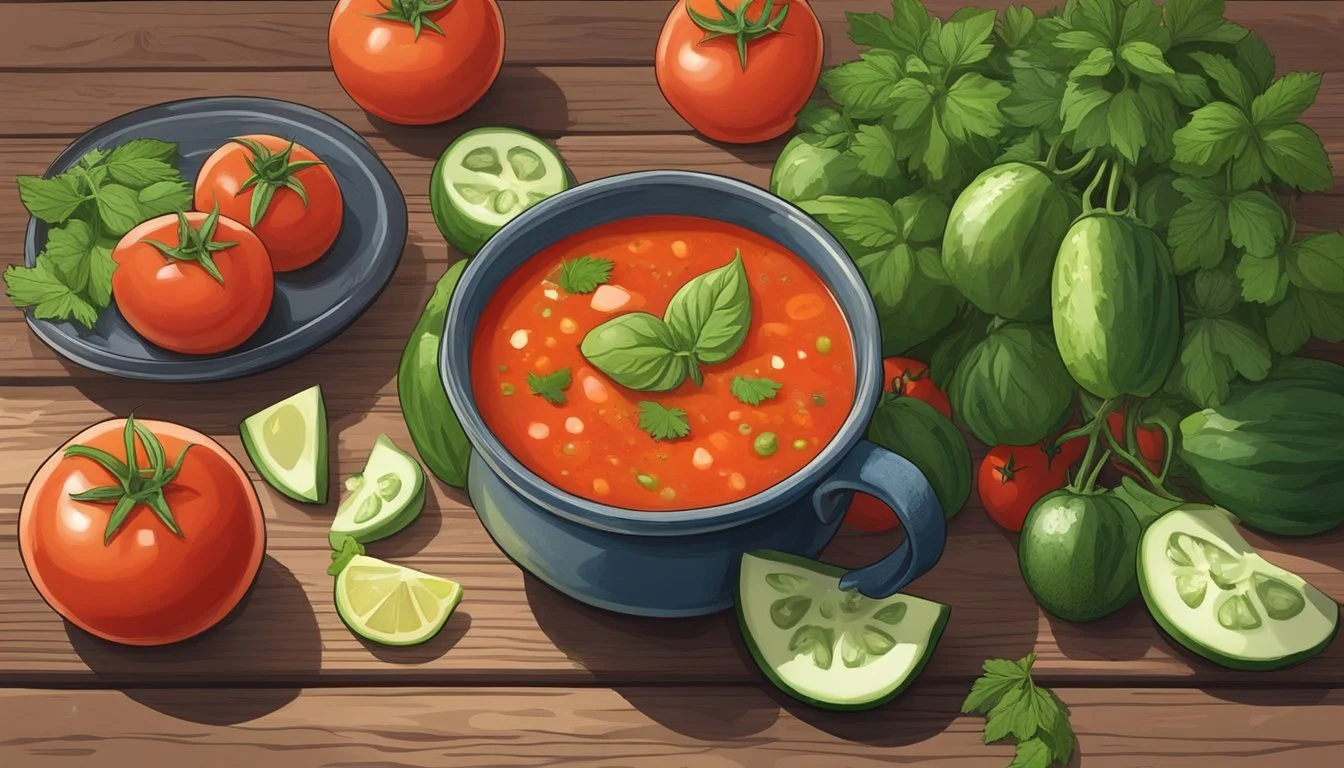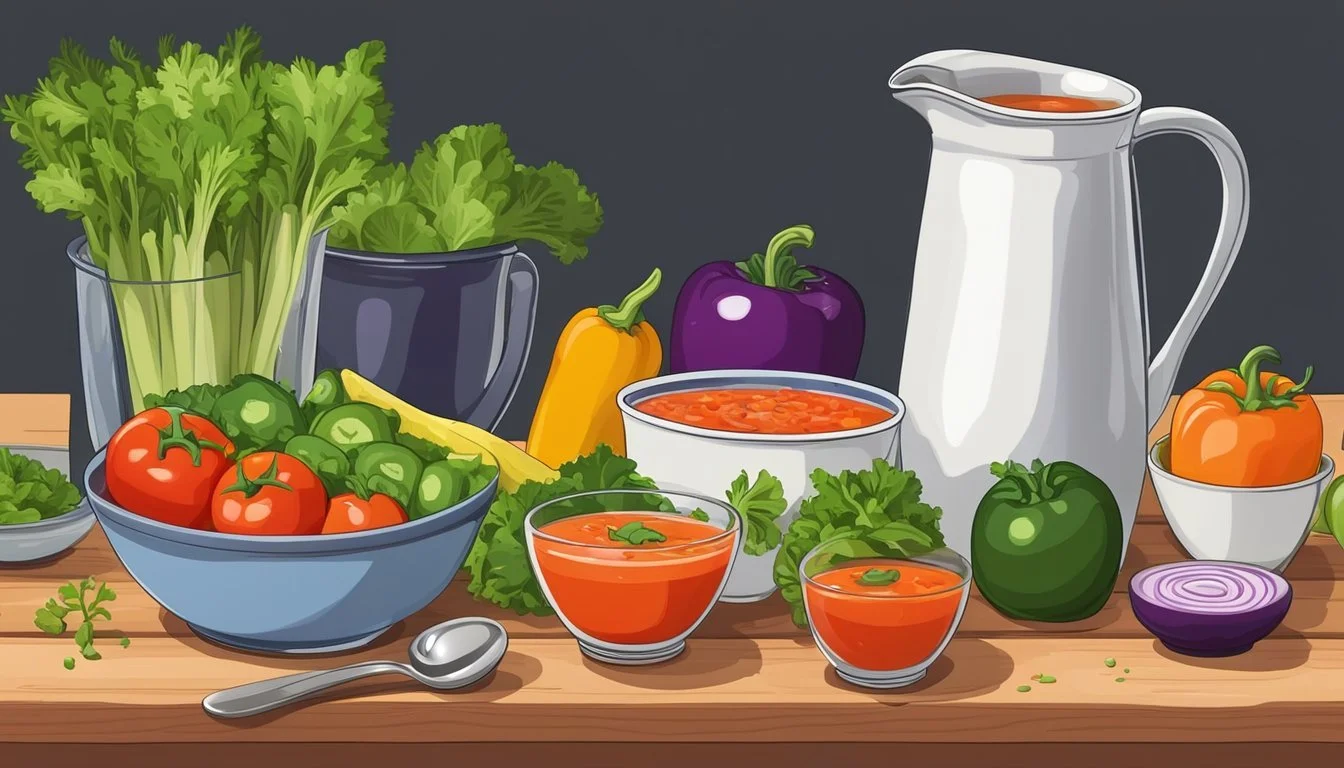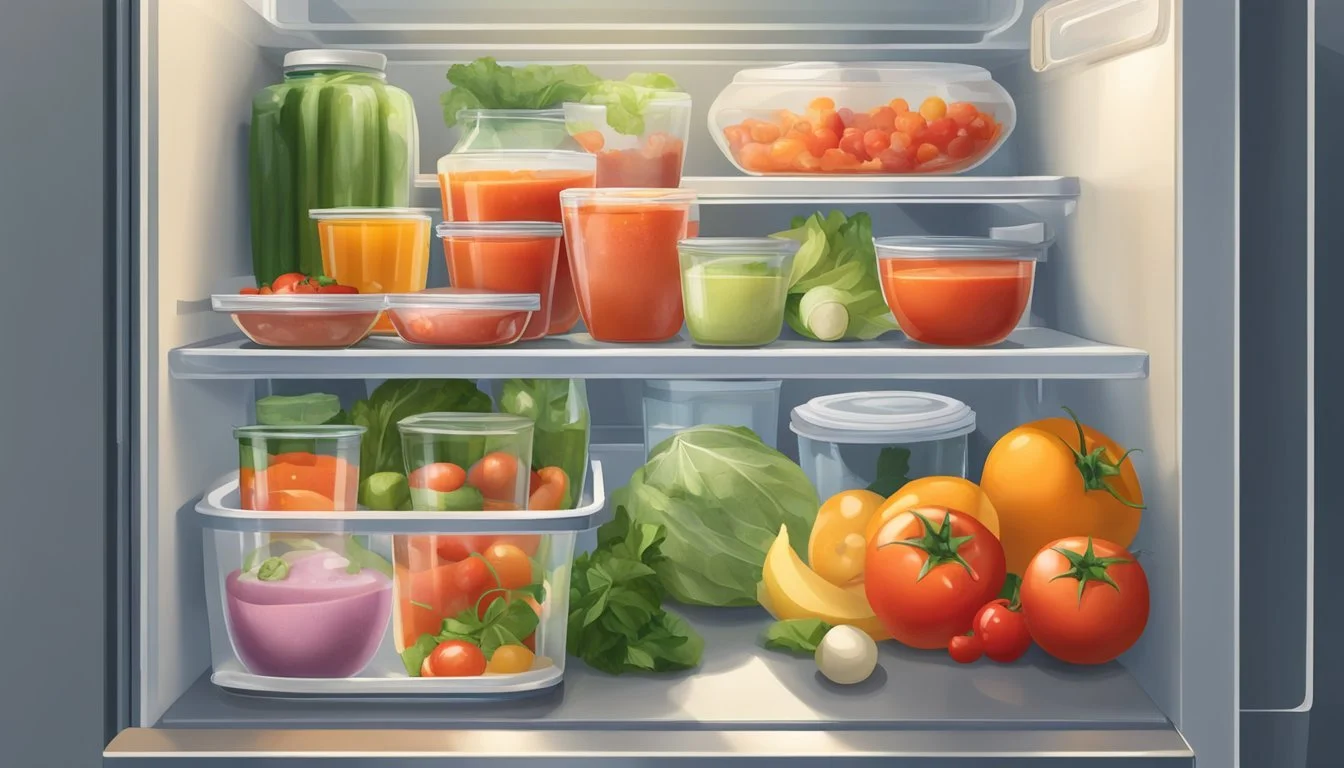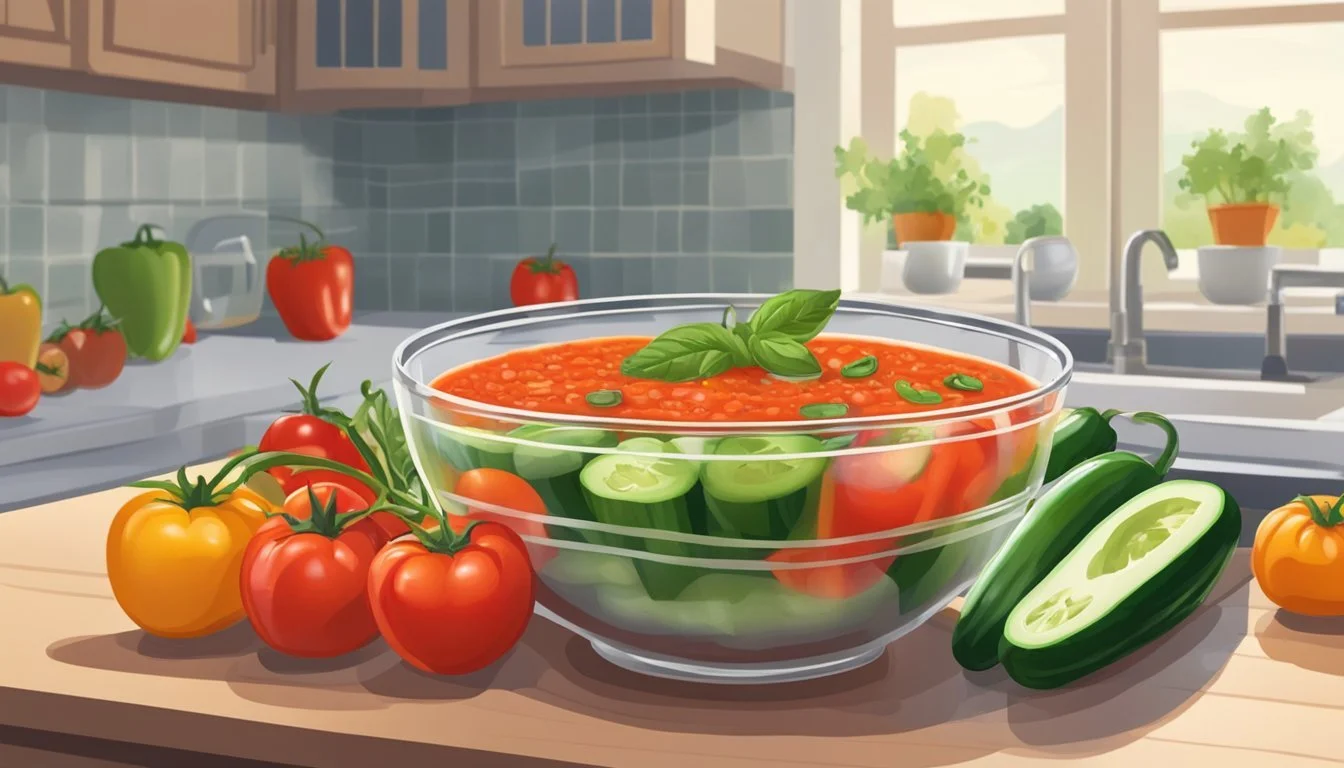How Long Does Freshly Prepared Gazpacho Last?
Shelf Life and Storage Tips
Gazpacho, a traditional Spanish soup, is synonymous with summer refreshment. As a chilled, raw vegetable soup, typically brimming with ripe tomatoes, cucumbers (how long do cucumbers last?), peppers, and onions, gazpacho provides a cooling respite from the heat. Given its fresh ingredients and no-cook preparation, it's a go-to recipe for those seeking a quick, nutritious, and cooling meal during the warmer months.
The shelf life of freshly prepared gazpacho is a topic of interest for anyone looking to savor this delightful dish. Because it lacks the preserving benefits of cooking, the freshness of the ingredients directly impacts its longevity. Typically, homemade gazpacho can last for 3 to 4 days in the refrigerator if stored properly in an airtight container to prevent oxidation and contamination from other foods.
Maintaining the quality of gazpacho also depends on meticulous food safety practices. It's crucial to promptly refrigerate the soup after preparation to inhibit bacterial growth. A precise balance between optimal enjoyment and food safety considerations will ensure that gazpacho retains its intended vibrant flavors and refreshing qualities for as long as possible.
Understanding Gazpacho
Gazpacho is a refreshing and nutritious cold soup from Andalusia, Spain, typically made with ripe tomatoes, cucumbers, peppers, onions, and a harmonious blend of vinegar and olive oil. This section explores the heritage, key components, and the innovative takes on this classic Spanish dish.
History and Origin
The origins of gazpacho trace back to Andalusia, a region in southern Spain, where it began as a humble peasant meal. Over time, this Spanish soup evolved, incorporating New World ingredients such as tomatoes and peppers, which are now central to the dish's signature flavor and vibrant color.
Traditional Ingredients
A classic gazpacho recipe includes a variety of fresh and wholesome ingredients:
Tomatoes: The foundation for its bright and tangy taste.
Cucumber: Offers a crisp texture and refreshing quality.
Bell Pepper: Provides a sweet and mild flavor.
Onion: Adds a sharp, piquant note.
Garlic: Lends depth with its intense and aromatic profile.
Typically, these vegetables are blended with extra virgin olive oil, sherry vinegar, and seasoning for a balanced, acidic kick that epitomizes gazpacho.
Variations and Modern Twists
Gazpacho has inspired countless variations, both within Spain and internationally. Chefs and home cooks have put their own spin on this versatile dish, creating versions that range from fruit-infused gazpachos to those augmented with garnishes like ham, hard-boiled egg, or croutons. Each variation caters to diverse palates while staying true to the essence of traditional gazpacho.
Preparation Basics
Success in creating a quality batch of gazpacho relies heavily on employing fresh, high-grade ingredients, following a trusted recipe, and utilizing proper blending techniques. Each step plays a pivotal role in influencing the final flavor and texture of the gazpacho.
Choosing Fresh Ingredients
When selecting ingredients for gazpacho, one should prioritize freshness to ensure the most vibrant flavors. Fresh, ripe tomatoes form the backbone of the soup, so choosing juicy, flavorful varieties is crucial. Other essentials include crisp cucumbers, sweet bell peppers, and potent garlic. Extra virgin olive oil enriches the gazpacho with its fruitiness, while vinegar imparts a balancing tangy profile.
Gazpacho Recipe Overview
A gazpacho recipe generally calls for blending raw vegetables with ingredients like bread, which traditionally thickens the soup, and seasonings to taste. Basic yet quality ingredients are merged to honor the simplicity and freshness of this classic dish. Seasoning typically involves modest amounts of salt, and sometimes ingredients such as cumin, for a touch of warmth, or a pinch of sugar to counterbalance the acidity.
Blending Techniques
For blending, achieving the perfect texture is a matter of preference between a smooth or chunky gazpacho. To initiate, one combines the prepped vegetables, garlic, olive oil, vinegar, bread (if used), and seasonings in a blender. The blending can be done in short pulses if a chunkier consistency is desired or in a longer, continuous mode for a smooth finish. A crucial piece of advice is to blend at medium-high speed and to taste adjust as needed, ensuring a harmonious blend of flavors.
Optimal Storage Practices
Ensuring fresh gazpacho maintains its quality involves proper storage. One must be mindful of temperature control and choose containers that will preserve freshness.
Temperature and Container Selection
It is essential to keep gazpacho cold to prevent bacterial growth and maintain its flavor. Gazpacho should be stored at a refrigeration temperature, ideally below 40°F (4°C). For container selection, one should use an airtight container to prevent contamination and odor transfer. Clear glass or food-grade plastic containers help monitor the soup's condition without opening it frequently.
Refrigeration Guidelines
To maximize the shelf life of leftover gazpacho, refrigerate promptly after serving. Homemade gazpacho usually has a refrigerated shelf life of 24-48 hours, but it can last up to 3-4 days if stored impeccably. Any refrigeration beyond this timeframe might compromise its freshness and flavor. Always use a clean utensil when serving gazpacho to avoid introducing bacteria that could reduce its shelf life.
Shelf Life of Gazpacho
Gazpacho, when freshly prepared and stored properly, has a shelf life of typically 3-4 days in the refrigerator. The freshness of gazpacho can be influenced by several factors, including the quality of ingredients and storage conditions.
Factors Affecting Freshness
The shelf life of gazpacho largely depends on the quality of fresh vegetables used and the temperature at which it is stored. High-quality ingredients and prompt refrigeration after preparation help extend the freshness. Leftovers should be stored in an airtight container to minimize exposure to air.
Key points:
Use fresh, high-quality vegetables.
Refrigerate immediately after preparation.
Store in airtight containers.
Visual and Olfactory Indicators
One can determine the freshness of gazpacho by looking for changes in color and smell. A dimming of the vibrant hues of the vegetables or an off-putting odor can signal that the gazpacho may no longer be fresh and should be discarded.
Signs of spoilage:
Color change from bright to dull.
Unpleasant or sour smell.
Health and Safety Considerations
When it comes to food safety, gazpacho should be consumed within the recommended time frame to avoid potential foodborne illness. Any gazpacho left out at room temperature for more than 2 hours should be discarded to prevent bacterial growth.
Safety tips:
Consume within 3-4 days.
Discard if left out for more than 2 hours at room temperature.
Serving Suggestions
When serving gazpacho, the key is to enhance its fresh flavor and present it in a way that appeals to the senses. Garnishes should be chosen for both visual appeal and taste complementarity, while accompanying dishes can range from simple to substantial to suit various appetites.
Appropriate Gazpacho Garnishes
To elevate the flavor of gazpacho, consider adding a variety of garnishes. These can be sprinkled on top just before serving:
Croutons: A handful of homemade or store-bought croutons adds a satisfying crunch.
Fresh Herbs: Chopped parsley, cilantro, or basil impart aroma and freshness.
Diced Vegetables: Extra pieces of cucumber, bell peppers (What wine goes well with bell peppers?), or onions provide texture contrasts.
Drizzles: A swirl of olive oil or a dash of sherry vinegar can enhance the soup's richness and acidity.
Complementary Dishes
Gazpacho pairs well with a range of dishes, serving as an appetizer or a side:
Grilled Seafood or Chicken: Light proteins complement the zesty nature of gazpacho.
Cheese platter: Offering a selection of cheeses can balance the gazpacho's acidity.
Bread: Serve alongside crusty baguette slices or warm pita bread for dipping.
Presentation Tips
The presentation of gazpacho can be customized to the occasion:
Glasses vs. Bowls: Serve in chilled glasses for a formal affair or in bowls for a casual meal.
Colors: Choose serving ware that contrasts with the vibrant red of the gazpacho to make it pop.
Temperature: Keep gazpacho refrigerated until serving to maintain its refreshing quality.
Expanding Gazpacho Experience
To extend the enjoyment of gazpacho beyond its freshness period, consider exploring new variations and pairings. Strategic choices can transform this classic dish into an adaptable centerpiece for any event or season.
Creative Gazpacho Variations
Gazpacho offers a versatile canvas for culinary creativity. Melon gazpacho blends the traditional tomato base with varieties of melon such as cantaloupe (how long does cantaloupe last?)or watermelon, delivering a sweet and refreshing twist ideal for summer months. Similarly, incorporating cherry tomatoes can offer a burst of sweetness and vibrant color. These variations not only enliven the palate but also provide additional options for those looking to serve gazpacho at events, ensuring a memorable gastronomic experience.
Traditional Tomato
Melon
Cantaloupe
Pairing with Beverages
The right beverage can enhance the flavors of gazpacho. When considering alcohol pairings, a crisp white wine or a light rosé complements the acidic and fresh notes of tomato-based gazpacho. For melon variations, a sparkling wine adds a festive touch. Non-alcoholic options such as iced herbal teas or infused waters with cucumber or mint are also excellent choices for balancing the gazpacho's robust profile.
Gazpacho Type Alcohol Pairing Non-Alcoholic Pairing Traditional Crisp white wine, rosé Iced herbal tea Melon Sparkling wine Cucumber-infused water
Event and Seasonal Considerations
Gazpacho is not only a delightful summer dish but also a versatile option for various events. Its cold, refreshing qualities make it a perfect fit for outdoor gatherings, barbecues, or summer weddings. For a seasonal spin, chefs can experiment with fall-inspired ingredients such as roasted pumpkin during autumn celebrations. Gazpacho's adaptable nature allows it to cater to different palates and festivities throughout the year, maintaining its stature as a beloved and enduring culinary staple.
Summer Events: Barbecues, weddings, picnics
Autumn Variations: Roasted pumpkin gazpacho
Frequently Asked Questions
How long does freshly prepared gazpacho last in the refrigerator? Freshly prepared gazpacho typically lasts for 3 to 4 days when stored in a refrigerator, in an airtight container.
Can gazpacho be frozen for longer storage? Yes, gazpacho can be frozen. Ideal storage is in an airtight container or zip-top freezer bag for up to 6 months.
How to serve gazpacho after thawing? Thaw gazpacho overnight in the fridge. If separation occurs, re-blend before serving to restore its texture.
What is the impact of freezing on gazpacho's texture? Freezing may alter gazpacho's texture. Though safe to consume, the texture may not be as smooth as when originally made.
Is gazpacho made with seasonal ingredients? Gazpacho is often made with seasonal ingredients such as ripe tomatoes, cucumbers, and bell peppers, which contribute to its fresh taste.
What should one do with leftover gazpacho? Leftover gazpacho should be stored in a sealed container in the refrigerator and consumed within 4-5 days for optimal freshness.
Any tips for making gazpacho last longer? To ensure maximum freshness:
Use the freshest ingredients possible.
Keep it refrigerated immediately after preparation.
Store in airtight containers to minimize exposure to air.
Remember, gazpacho's flavor can deepen while refrigerated, but one should always prioritize food safety and consume within recommended time frames.









